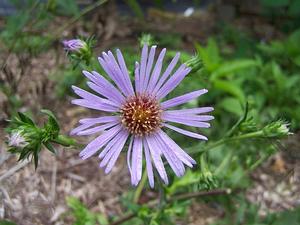Printed at http://www.quackingrassnursery.com/index.cfm/
Aster novae-angliae 'Skyscraper'
New England Aster
Plant Type:
SUN PERENNIALSAster novae-angliae 'Skyscraper' (syn. Symphyotrichum) - Large lavender discs up to three inches diameter with warm honey-amber central puffs explode late season on stems to six feet creating a light purple cloud. Great for mid to back-of-the-border color this tall boy will draw bees, butterflies and many other pollinators performing the double duty of utilitarian maintenance of many species and aesthetic wonder to people. Though tolerant of poor soil 'Skyscraper' will rise strong and proud in average to modestly fertile ground. Fully to mostly sunny exposure. This will be just perfect with Buddleia davidii 'White Profusion, any among the solidagos, Vernonia, Eupatorium, Amsonia ssp. as the latter's foliage turn gold in autumn and don't forget the late and very late daylilies; with these you will create a sumptuous late season display satisfying human aesthetic and satiating pollinator requirements. We're uncertain whether or not 'Skyscraper' was collected in the wild or is of garden origin. Established potted New England Aster from cutting or division.
Characteristics and Attributes for Aster novae-angliae 'Skyscraper'
Season of Interest (Flowering)
- Late Summer
Season of Interest (Foliage)
- Spring / Summer
Nature Attraction
- Butterflies
- Honey Bees & Native Bees
Light
- Full Sun
- Mostly Sunny
Attributes
- Border
- Grass Garden
- Natural Garden
- Meadow / Field
- Cutting Garden
- Cottage Garden
- Wildlife Garden
- Filler
Growth Rate in the Garden
- Moderately Fast
Soil
- Draining
- Fertile
- Average
Propagated By
- Cutting
- Division



